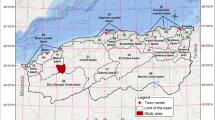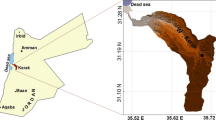Abstract
The amount, degree of severity, and risk of soil erosion in managed landscapes mainly depend on human activities such as vegetation removal, grazing, urbanisation, poor agricultural management, and planned burning. However, the underlying mechanisms that ultimately drive the activities causing soil erosion for a particular location are less obvious. We address this issue by integrating stakeholder perceptions of socio-economic determinants of soil erosion and the revised universal soil loss equation (RUSLE) for the Phewa watershed, Pokhara, Nepal. A RUSLE model was applied to estimate the soil erosion status of the watershed based on socioeconomic-topographical factors. The output of the model indicated that the current annual rate of soil erosion in the Phewa watershed varies from 0 to 206.8 t ha−1 year−1, with a mean annual soil loss rate of 14.7 t ha−1 year−1. We used a structured questionnaire to collect socio-economic variables related to soil erosion in the watershed. Bivariate correlation and stepwise multiple regression analyses revealed ten socio-economic variables that were predictors of soil erosion. The analysis generated five predictive models: the first (R 2 = 0.65), second (R 2 = 0.71), third (R 2 = 0.79), and fourth model (R 2 = 0.85) significantly (p < 0.01) explained the variability of soil erosion rate across the watershed, while the fifth (full) model significantly (p < 0.01) explained 89 % of the variability of soil erosion rate (R 2 = 0.89). Our study identified socio-economic variables such as household size, farm labour availability, level of education, conservation cost, training, membership of organisation committees, distance, farm size, migration, and farm income as predictor variables of soil erosion.










Similar content being viewed by others
References
Bartsch KP, Van Miegroet H, Boettinger J, Dobrwolski JP (2002) Using empirical erosion models and GIS to determine erosion risk at Camp Williams. J Soil Water Conserv 57:29–37
Boggs G, Devonport C, Evans K, Puig P (2001) GIS-based rapid assessment of erosion risk in a small catchment in the wet/dry tropics of Australia. Land Degrad Dev 12:417–434
Burrough PA, McDonnell RA (1998) Principles of geographical information systems, 2nd edn. Oxford University Press, Oxford, p 352. ISBN:978-0-19-823365-7
CBS (2001) HMG/N, National Planning Commission Secretariat, Central Bureau of Statistics, Kathmandu
Cerri CEP, Dematte JAM, Ballester MVR, Martinelli LA, Victoria RL, Roose E (2001) GIS erosion risk assessment of the Piracicaba River Basin, southeastern Brazil. Mapp Sci Remote Sens 38:157–171
El-Swaify SA, Dangler EW, Armstrong CL (1982) Soil erosion by water in the tropics. College of Tropical Agriculture and Human Resources, University of Hawaii, USA
Ervin CA, Ervin DE (1982) Factors affecting the use of soil conservation practices: hypotheses, evidence, and policy implications. Land Econ 58:277–292
Fleming WM (1978) Phewa Tal Watershed management Proposal. IWMP, Department of soil and water conservation, Ministry of Forest, Kathmandu
Fort M (1987) Sporadic Morphogenesis in a Continental Seduction setting, an example from the Annapurna Range, Nepal Himalaya Z, Geomorphic, NF
Fort M, Freytet P (1982) The quaternary sedimentary evolution of the intra-montane basin of Pokhara in relation to the Himalaya midlands and their hinterland (west central Nepal), contemporary Geosciences researches in Himalaya, vol 2
Hashim GM, Wong NC (1988) Erosion from steep land under various plant covers and terrains. In: Tay TH, Mokhtaruddin AM, Zahari AB (eds) Steep land agriculture in the humid tropics. MARDI/Malaysian Society of Soil Science, Kuala Lumpur, pp 24–61
Hurni H (1987) Erosion–productivity–conservation systems in Ethiopia. In: Soil conservation and productivity. Proceedings of the 4th international soil conservation conference, pp 654–674
ICIMOD (1994) Constraints and opportunities. In: Proceedings of the international symposium on mountain environment and development, International Centre for Integrated Mountain Development (ICIMOD), Kathmandu, Nepal
Illukpitiya P, Gopalakrishnan C (2004) Decision-making in soil conservation: application of behavioral model to potato farmers in Sri Lanka. Land Use Policy 21:321–331
Ives JD, Messerli B (1989) The theory of Himalayan environmental degradation. What is the nature of the perceived crisis? The Himalayan dilemma reconciling development and conservation. Routledge, New York
Jain SK, Kumar S, Varghese J (2001) Estimation of soil erosion for a Himalayan watershed using GIS technique. Water Resour Manag 15:41–54
Knisel WG (1980) CREAMS: a fieldscale model for chemical, runoff, and erosion from agricultural management systems. USDA, Science and Education Administration, Conservation Report No. 26, Washington, DC
Kok K, Clavaux MBW, Heerebout WM, Bronsveld K (1995) Land degradation and land cover change detection using low-resolution satellite images and the CORINE database—a case study in Spain. ITC J 3:217–228
Kouli M, Soupios P, Vallianatos F (2009) Soil erosion prediction using the revised universal soil loss equation (RUSLE) in a GIS framework, Chania, North Western Crete, Greece. Environ Geol 57:483–497
Lal R (2001) Soil degradation by erosion. Land Degrad Dev 12:519–539
Laurini R (2004) SIG pour la participation des citoyens aux décisions relatives à l’aménagement du territoire. Tech territoires sociétés 37:209–219
Lewis LA, Verstraeten G, Zhu H (2005) RUSLE applied in a GIS framework: calculating the LS factor and deriving homogeneous patches for estimating soil loss. Int J Geogr Inf Sci 7:809–829
Lu D, Li G, Valladares GS, Batistell M (2004) Mapping soil erosion risk in Rondonia, Brazilian Amazonia: using RUSLE, remote sensing and GIS. Land Degrad Dev 15:499–512
Mainam F (1999) Modeling soil erodibility in the semi-arid zone of Cameroon. Unpublished PhD thesis, ITC, Enschede
Millward AA, Mersey JE (1999) Adapting the RUSLE to model soil erosion potential in a mountainous tropical watershed. Catena 38(2):109–129
Morgan RPC (1986) Processes and mechanics of erosion, ch. 2. In: Davidson DA, Morgan RPC (eds) Soil erosion and conservation. Longman, London, pp 12–39
Morgan RPC (2009) Soil erosion and conservation. Blackwell, Malden
Morgan RPC, Quinton JN, Smith RE, Govers G, Poesen JWA, Auerswald K, Chisci G, Torri D, Styczen ME (1998) The European Soil Erosion Model (EUROSEM): a dynamic approach for predicting sediment transport from fields and small catchments. Earth Surf Process Landf 23:527–544
Moulder RP (1978) A soil survey of Phewa Tal Catchment. Integrated Watershed Management Project, Department of soil Conservation and Watershed Management, Ministry of Forests, Kathmandu, Nepal, 4:57
Nearing MA, Foster GR, Lane LJ, Finkner SC (1989) A process-based soil erosion model for USDA Water Erosion Prediction Project technology. Trans ASAE 32(5):1587–1593
Pandey A, Chowdary VM, Mal BC (2009) Sediment yield modeling of an agricultural watershed using MUSLE, remote sensing and GIS. J Paddy Water Environ (Springer) 7(2):105–113
Pender JL, Kerr JM (1998) Determinants of farmers’ indigenous soil and water conservation Investments in Semi-Arid India. Agric Econ 19:113–125
Pimentel D, Harvey C (1995) Environmental and economic costs of soil erosion and conservation benefits. Science 267(5201):1117–1123
Rambaldi G, Weiner D (2004) Summary proceedings of the track on international PPGIS perspectives. In: 3rd international conference on public participation GIS University of Wisconsin-Madison, 18–20 July Madison, Wisconsin, USA
Renard KG, Freimund JR (1994) Using monthly precipitation data to estimate the R- Factor in the revised USLE. J Hydrol 157:287–306
Renard KG, Foster GR, Weesies GA, McCool DK, Yoder DC (1997) Predicting soil erosion by water: a guide to conservation planning with the Revised Universal Loss Equation (RUSLE). Agriculture Handbook No. 703. USDA, Agricultural Research Service, Washington, DC
Reusing M, Schneider T, Ammer U (2000) Modeling soil erosion rates in the Ethiopian Highlands by integration of high resolution MOMS-02/D2-stereo-data in a GIS. Int J Remote Sens 21:1885–1896
Roose EJ (1977) Application of the universal soil loss equation of Wischmeier and Smith in West Africa. In: Greenland DJ, Lal R (eds) Soil conservation and management in the humid tropics. Wiley, London, pp 177–187
Schawb G, Fangmeier D, Elliot W, Frevert R (1993) Soil and water conservation engineering. Wiley, NY
Shahriar MW, Mukand SB, Ashim DP, Jayant KR (2008) Degradation–environment–society spiral: a spatial auto- logistic model in Thailand. Nat Resour Forum 32:290–304
Shrestha DP (1997) Assessment of soil erosion in the Nepalese Himalaya, a case study in LikhuKhola Valley, Middle mountain region. Land Husbandry 2(1):59–80. Oxford & IBH Publishing Co. Pvt. Ltd
Simms AD, Woodroffe CD, Jones BG (2003) Application of RUSLE for erosion management in a coastal catchment, southern NSW. Faculty of Science-Papers 34. http://ro.uow.edu.au/cgi/viewcontent.cgi?article=1034&context=scipapers. Accessed on 24 Mar 2013
Srinivas CV, Maji AK, Reddy GPO, Chary GR (2002) Assessment of soil erosion using remote sensing and GIS in Nagpur district, Maharashtra for prioritization and delineation of conservation units. J Indian Soc Remote Sens 30(4):197–212
Sui J, He Y, Liu C (2009) Changes in sediment transport in the Kuye River in the Loess Plateau in China. Int J Sedim Res 24:201–213
Trahan N (2013) Modeling sediment and contaminant pathways to the Cedar River. http://proceedings.esri.com/library/userconf/proc02/pap0785/p0785.htm. Accessed on 12 Mar 2013
Udayakumara EPN, Shrestha RP (2010) People’s perception and socioeconomic determinants of soil erosion: a case study of Samanalawewa watershed, Sri Lanka. Int J Sedim Res 25(4):323–339
UNEP (1997) Asia Pacific Environment Outlook. United Nations Environment Programme (UNEP)—Environment Assessment Programme for Asia and Pacific, Asian Institute of Technology, Bangkok, Thailand
Wang G, Gertner G, Fang S, Anderson AB (2003) Mapping multiple variables for predicting soil loss by geo statistical methods with TM images and a slope map. Photogramm Eng Remote Sens 69:889–898
Wischmeier WH, Smith DD (1978) Predicting rainfall erosion losses. A guide to conservation planning. US Department of Agriculture, Agriculture Handbook, vol 537, Washington, DC, p 85
Yamanaka H (1982) Radiocarbon ages of Upper Quaternary Deposit in Central Nepal and their geomorphological significance. Sci Rep Tohoku Univ Sendai Jpn 32(1):46–60
Acknowledgments
We would like to thank all of the participants who contributed to our study. We acknowledge two anonymous reviewers for their time in providing valuable comments on the earlier versions of the manuscript.
Author information
Authors and Affiliations
Corresponding author
Rights and permissions
About this article
Cite this article
Bhandari, K.P., Aryal, J. & Darnsawasdi, R. A geospatial approach to assessing soil erosion in a watershed by integrating socio-economic determinants and the RUSLE model. Nat Hazards 75, 321–342 (2015). https://doi.org/10.1007/s11069-014-1321-2
Received:
Accepted:
Published:
Issue Date:
DOI: https://doi.org/10.1007/s11069-014-1321-2




